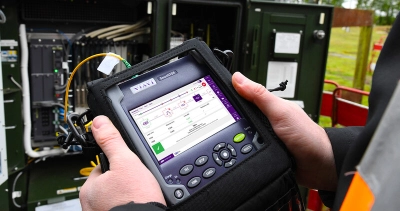High-performance fibre testing equipment is essential for reliable material quality assessment.
High-performance fibre testing equipment is essential for reliable material quality assessment.
Blog Article
Discovering the Perks of Optical Fiber Evaluating for Enhanced Interaction Solutions
The importance of optical fiber testing in modern interaction systems can not be overstated, as it works as a foundation for ensuring network dependability and efficiency. Utilizing sophisticated methodologies such as Optical Time-Domain Reflectometry (OTDR) and insertion loss evaluation, companies can not just identify mistakes but likewise maximize their configurations. This aggressive screening approach has extensive implications for signal top quality and operational effectiveness, raising the concern of how these methods add to long-lasting sustainability in an ever-evolving technological landscape. Recognizing these dynamics is essential for stakeholders aiming to keep a competitive side.
Value of Optical Fiber Screening
The importance of optical fibre testing can not be overemphasized in today's data-driven setting. As companies increasingly count on high-speed information transmission for daily procedures, the honesty and performance of optical fibre networks are paramount. Evaluating makes sure that these networks can sustain the substantial quantities of information generated and transmitted perfectly, promoting reliable interaction and connection.
Optical fiber screening offers numerous critical functions, including verifying installation quality, identifying potential mistakes, and determining overall system performance. Regular screening can protect against pricey downtimes and service disruptions, allowing companies to keep functional connection. It assists in conformity with market standards and laws, making certain that fibre optic installations fulfill called for specs for safety and integrity.
Furthermore, testing can boost the long life of fibre optic systems. By proactively identifying concerns such as signal loss, attenuation, or connector failings, organizations can resolve issues before they rise, therefore expanding the life of their facilities. In summary, optical fibre screening is not merely a technological demand yet a calculated investment that boosts network dependability, maximizes efficiency, and ultimately sustains the growth and performance of contemporary communication systems.
Trick Evaluating Approaches
OTDR is an important method made use of to determine faults, action splice losses, and assess the overall integrity of a fibre optic web link. By sending out a pulse of light down the fiber and analyzing the reflected light, technicians can determine areas of mistakes and assess the network's efficiency over lengthy ranges.
Insertion loss testing measures the amount of signal loss that happens when light passes via a link or splice. This method is important for verifying that connections fulfill specified loss thresholds, which is vital for preserving ideal performance in interaction systems.
Optical return loss testing quantifies the amount of light reflected back towards the source because of flaws in the fiber or links. High return loss values indicate much better performance and minimized signal deterioration.
With each other, these testing methods supply a detailed evaluation of fiber optic networks, ensuring their dependability and capability in varied interaction applications.
Effect On System Efficiency
Reliable optical fiber testing directly influences the total efficiency of interaction systems. By making sure the stability of fibre optic cable televisions, testing recognizes possible mistakes such as attenuation, splice loss, and connector misalignment. These concerns can dramatically break down signal high quality, resulting in interruptions and decreased information transmission rates.

Furthermore, normal optical fibre screening adds to long-lasting system sustainability. It enables early discovery of deterioration, enabling prompt maintenance and upgrades before major failures take place. This not only lengthens the life expectancy of the framework however additionally ensures that interaction systems stay affordable in terms of efficiency.
Cost-Effectiveness and Efficiency
Cost-effectiveness is a critical consideration in the release and upkeep of optical fibre networks. Carrying out durable optical fibre testing procedures can dramatically decrease operational prices by identifying problems prior to they rise into major issues. optical fibre testing equipment. By spotting mistakes, depletion, and various other efficiency hindrances early, organizations can prevent expensive fixings and downtime, which can interfere with services and result in earnings loss
Furthermore, efficient screening techniques enhance the setup process, permitting professionals to Continue work better. This converts to reduce labour prices and faster task completion times. Advanced testing tools, such as Optical Time Domain Reflectometers (OTDRs), makes it possible for an exact evaluation of fibre quality, making certain that just optimal products are used, therefore reducing waste.
Regular screening also adds to much better resource allowance. By understanding the network's efficiency, organizations can make enlightened decisions concerning upgrades and growths, making certain that investments are made where they are most required. In summary, optical fiber testing improves cost-effectiveness and efficiency, supporting the lasting sustainability and competition of interaction systems in a progressively requiring market.
Making Sure Long-Term Reliability
Carrying out rigorous optical fibre screening not only improves cost savings and functional efficiency however additionally plays a critical duty in ensuring the long-term dependability of interaction networks. Consistent testing techniques, including attenuation and transmission capacity assessments, assistance recognize potential destruction in fiber performance before it brings about service disruptions.
By employing advanced testing methodologies, network drivers can identify mistakes or weak points in the fiber facilities, enabling prompt removal. This proactive strategy decreases downtime, making sure that interaction systems continue to be functional and efficient. Routine testing Click This Link contributes to the growth of an extra resistant network, as drivers can adapt and enhance their infrastructure based on real-time data understandings.
In addition, making certain conformity with market standards through optical fiber screening strengthens the high quality and honesty of the entire interaction system. This adherence not just reinforces confidence amongst stakeholders yet likewise aligns with regulatory needs, which are progressively strict.
Conclusion
To conclude, optical fiber testing serves as a basic element in improving communication systems. By using different testing approaches, such as OTDR and insertion loss evaluations, networks can achieve ideal performance and integrity. The positive identification of mistakes not only boosts signal high quality but additionally decreases downtime, ultimately adding to cost-effectiveness and operational effectiveness. Additionally, adherence to sector link requirements fosters stakeholder self-confidence, ensuring the lasting sustainability of communication frameworks in an increasingly data-driven landscape.
Report this page